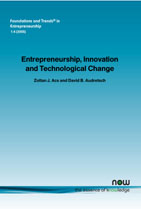Entrepreneurship, Innovation and Technological Change
By Zoltan J. Acs, Center for Entrepreneurship and Public Policy, School of Public Policy, George Mason University, USA, zacs@ubalt.edu | David B. Audretsch, Max Planck Institute of Economics, Group Entrepreneurship, Growth and Public Policy, Germany and Institute for Development Studies, School of Public and Environmental Affairs, Indiana University, USA, audretsch@mpiew-jena.mpg.de
Abstract
This survey links the prevalent theory from the entrepreneurship literature concerning opportunity recognition and exploitation to economic theory, in particular the model of the knowledge production function. The debate and evidence regarding the relationship between innovative activity and organizational context is examined. The role that the external knowledge context or what has become known as knowledge spillovers and geographic location plays in innovative activity is analyzed. Based on new theoretical models combined with compelling empirical evidence, the authors offer a reinterpretation of the role of entrepreneurship in innovative activity and technology.
Entrepreneurship, Innovation and Technological Change
Entrepreneurship, Innovation and Technological Change takes the position that entrepreneurship has an organizational component and involves the creation of new enterprises. This reflects the view that entrepreneurship involves individuals creating new organizations rather than individuals who are involved with established organizations. Thus, what distinguishes entrepreneurship from innovation is the organizational context. Entrepreneurship, Innovation and Technological Change links the prevalent theory from the entrepreneurship literature concerning opportunity recognition and exploitation to economic theory, in particular the model of the knowledge production function. The debate and evidence regarding the relationship between innovative activity and organizational context is examined in the third section. The fourth section examines the impact that the external industry context exerts on technological change. The role that the external knowledge context or what has become known as knowledge spillovers and geographic location plays in innovative activity is explained in the fifth section. The sixth section offers a reinterpretation of the role of entrepreneurship in innovative activity and technology. Finally, a summary and conclusions are provided.
